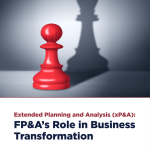At the fifth AI/ML FP&A Committee meeting, Igor Panivko, FD & MD at Konica Minolta, talked...

The pace and complexity of marketing has increased dramatically over the years. The times when single-channel marketing, such as television advertising, dominated the strategy are long gone. Today’s organisations must implement an omnichannel marketing strategy to present precise and consistent messaging to their audience, regardless of the medium. This complexity requires tremendous planning and coordination. An automated marketing planning process and system gives organisations a massive advantage over companies that manually plan and track their marketing investments.
Extended Planning and Analysis (xP&A) is a complete transformation of the FP&A function. It moves beyond just the finance function to challenge the status quo, educate, and continually influence management decisions. Modern marketing planning is an essential aspect of xP&A: it is a collaborative, agile and analytical process that creates bridges between finance and marketing teams. This collaboration is difficult to achieve in traditional planning and budgeting frameworks.
An integrated and analytical approach to marketing planning is an essential requirement of xP&A transformation.
The Challenges of a Manual Planning Environment
Marketing spend is often a short-term discretionary expense that helps organisations manage their bottom-line performance. As an FP&A professional, I have faced many urgent business situations which require either a marketing spend reduction or a potential increase.
The process of working with the marketing team to provide the spend by brand, channel and period has been incredibly challenging. It presents a significant challenge when senior management tries to understand the marketing spend drivers to make important business decisions related to the marketing plan.
Top 5 Benefits of the Integrated Marketing Planning System
The Integrated FP&A process connects all organisational planning processes through key drivers, models, analytics, and systems. An integrated marketing planning model is extremely appealing to FP&A professionals, as it offers the following five benefits:
-
Speed
Marketing professionals can generate their plans directly in the system. They can create programs and get them approved by their leadership in real-time, which improves the speed of program planning and execution.
-
Visibility
FP&A professionals can view and slice and dice proposed or actual marketing spending in many ways. They can see the proposed marketing spend by channel, brand, and type in the system without much back and forth with the marketing team.
-
Effectiveness
An automated approach gives management a holistic view of the entire organisation’s marketing spend. This ensures the approach is managed effectively across the organisation, rather than each division or brand managing their marketing spend.
-
Flexibility
FP&A teams can run multiple ‘what-if’ scenarios that help the organisation develop and manage marketing plans. Rather than having a ‘fire drill’ approach to implementing marketing reductions or investments, the FP&A team can proactively have a list of discretionary marketing programs.
-
Improved Reporting
FP&A and marketing can provide value-added reporting to management based on the business need. They can slice and dice the reporting by channel, brand, period, currency, or whatever business leaders require.
Implementing Integrated Marketing Planning
Critical success factors involved in implementing integrated marketing planning include:
- Investment in cultural transformation, including Change Management, starting with senior leaders and extending to all organisational team members.
- A truly collaborative approach – FP&A professionals must work collaboratively with marketing partners. They must build trust and effective collaboration, including joint accountability.
- Investment in dynamic models, processes and technology will enable marketing to be integrated into the overall financial system.
In Summary
Organisations that invest in integrated marketing planning will have a significant competitive advantage, as their FP&A departments will have a more informed and accurate understanding of the marketing plan. It will lead to more effective and efficient marketing investment decisions — and, ultimately, financial results.
This article was first published on the SAP blog.
Subscribe to
FP&A Trends Digest

We will regularly update you on the latest trends and developments in FP&A. Take the opportunity to have articles written by finance thought leaders delivered directly to your inbox; watch compelling webinars; connect with like-minded professionals; and become a part of our global community.






